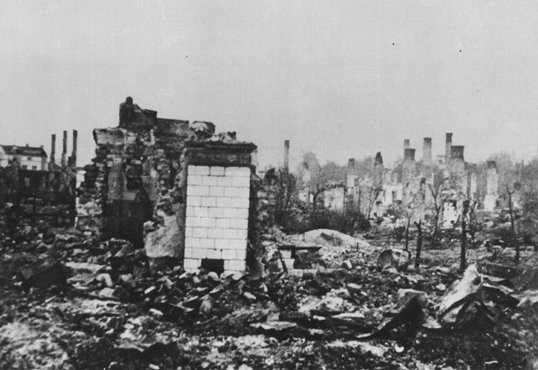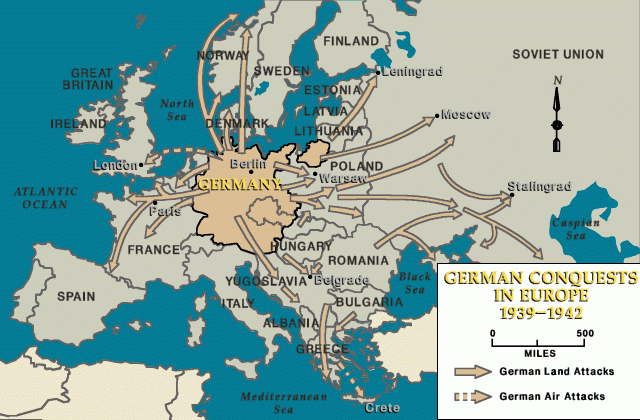
Blitzkrieg (Lightning War)
"Blitzkrieg," a German word meaning “Lightning War,” was Germany’s strategy to avoid a long war in the first phase of World War II in Europe. Germany's strategy was to defeat its opponents in a series of short campaigns.
Germany quickly overran much of Europe and was victorious for more than two years by relying on this new military tactic of "Blitzkrieg." Blitzkrieg tactics required the concentration of offensive weapons (such as tanks, planes, and artillery) along a narrow front. These forces would drive a breach in enemy defenses, permitting armored tank divisions to penetrate rapidly and roam freely behind enemy lines, causing shock and disorganization among the enemy defenses. German air power prevented the enemy from adequately resupplying or redeploying forces and thereby from sending reinforcements to seal breaches in the front. German forces could in turn encircle opposing troops and force surrender.
Germany successfully used the Blitzkrieg tactic against
- Poland (attacked in September 1939)
- Denmark (April 1940)
- Norway (April 1940)
- Belgium (May 1940)
- the Netherlands (May 1940)
- Luxembourg (May 1940)
- France (May 1940)
- Yugoslavia (April 1941)
- Greece (April 1941)
Germany did not defeat Great Britain, which was protected from German ground attack by the English Channel and the Royal Navy.

Despite the continuing war with Great Britain, German forces invaded the Soviet Union in June 1941. At first, the German Blitzkrieg seemed to succeed. Soviet forces were driven back more than 600 miles to the gates of Moscow, with staggering losses. In December 1941, Hitler unilaterally declared war on the United States, which consequently added its tremendous economic and military power to the coalition arrayed against him. A second German offensive against the Soviet Union in 1942 brought German forces in the east to the shores of the Volga River and the city of Stalingrad. However, the Soviet Union launched a counteroffensive in November 1942, trapping and destroying an entire German army at Stalingrad.
Germany proved unable to defeat the Soviet Union, which together with Great Britain and the United States seized the initiative from Germany. Germany became embroiled in a long war, leading ultimately to its defeat in May 1945.
Critical Thinking Questions
- Investigate standard military procedures for attacking the enemy in conflicts before World War II. How was the Blitzkrieg different? Why was it so effective?
- What was the relationship between the progress of the war and the mass murder of Europe’s Jews?
- Are there any equivalents to Blitzkrieg in modern warfare?

